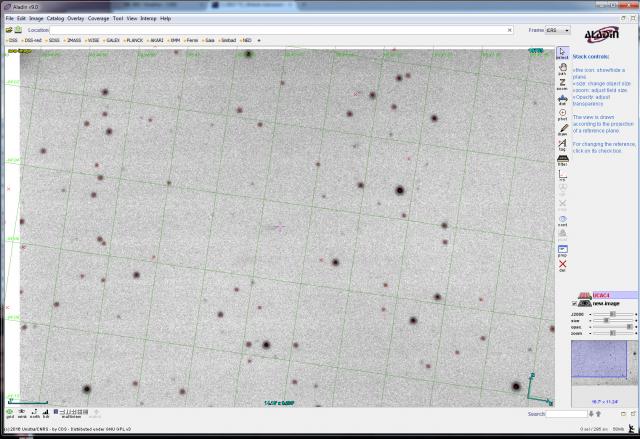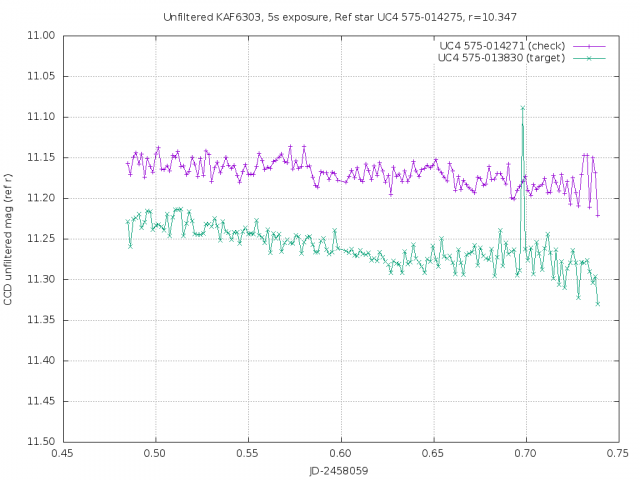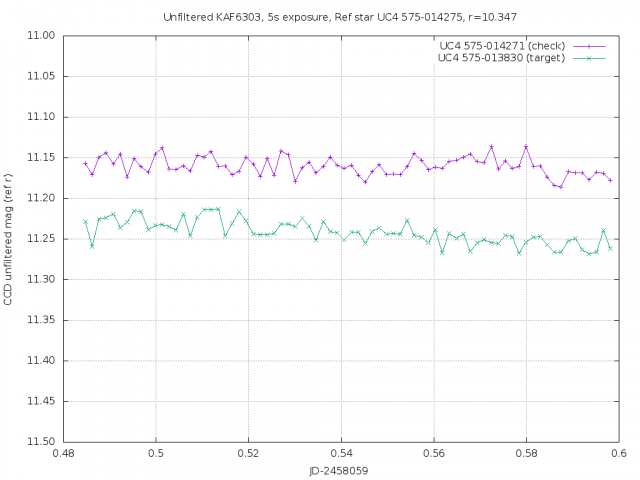Forum Replies Created
-
AuthorPosts
-
 Nick JamesParticipant
Nick JamesParticipantYou don’t need the HD version of UFO capture for SD cameras. I’m using UFO Capture V2.24 under Windows 7/64-bit. The PC has three PCI Osprey 210 video capture cards and I run three instances of UFO capture for three cameras, 2 Watec 902H2s and 1 other B&W monitor camera. The PC is an old Dell Optiplex 780 with an Intel E8400 CPU running at 3GHz and 8 GB of memory. Each instance of UFO Capture uses around 150MB of memory so they are very lightweight. Each instance will use a different CPU core if it can and even with all three cards detecting the CPU load never goes above 30%
I certainly prefer having a PCI card for the video capture since I occasionally had dropped frames using a USB dongle. The Osprey 210 is a really nice card. They are a bit pricey but occasionally come up at a decent price on ebay. I’ve never had any problems since I started using it.
I don’t know the details of their licensing model but the problem is solved if you use a single PC.
 Nick JamesParticipant
Nick JamesParticipantJimmy, Thanks for pointing me at Baker’s work. I really should have known about him as a famous local writer. I’ve bought The Peregrine from Amazon and look forward to reading it.
 Nick JamesParticipant
Nick JamesParticipantYes, Denis does live in a fantastic location. I’ve visited many times and the scenery and skies are stunning. I was only teasing him, slightly, over the temperatures. I would have thought that it was too windy on Tarbatness for midges but I did suffer from them at the Falls of Shin the last time I was up although that was mainly my fault for wearing inappropriate clothing.
 Nick JamesParticipant
Nick JamesParticipantI don’t keep stats on how many nights that I observe since they would be dependent on many more things than the weather. My meteor cameras are running every night though so stats from them do have some significance. In 2017 I detected 3751 meteors on two cameras (4451 in 2016) and I detected at least one meteor on 227 mornings and 180 evenings (238 and 189 in 2016) so it does look as if 2017 was a bit cloudier than 2016.
Also, slightly off topic, I attach the max/min temperatures for my back garden weather station over the past three years. Denis may get the best observing weather but how many days were over 20C last year?
 Nick JamesParticipant
Nick JamesParticipantI think corkscrewing meteors with this kind of observable transverse displacement are physically impossible.
A very hand-wavey argument goes as follows (although you might like to check my maths since I worked this out while cycling home tonight). Let’s assume the meteor has an entry velocity of 60 km/s and it decelerates to zero in 1s. That means it is visible for a track of length 30km. Your photos show around 7 cycles of wiggles with an amplitude of around 1/50 of the trail length, so let’s say 600m. That’s +/- 600m transverse displacement in 1/7s. Assuming the transverse displacement is sinusoidal the peak transverse velocity would then be 600*(2*pi*7) m/s and the peak transverse acceleration would be 600*(2*pi*7)^2. This would require a sinusoidally acting transverse force more than 40 times the along-track drag force. That is just not physically possible.
I still think the best explanation of this is wind vibration.
 Nick JamesParticipant
Nick JamesParticipantOne other explanation which I have seen in practice on my images is wind vibration of the camera. This can have a negligible effect on the star images since they are integrated over minutes but show up very clearly on meteors which are only present for a fraction of a second. You even see this on trailed objects like minor planets in long exposure images. If this were a real, physical effect on the meteroid itself you should be able to calculate the transverse acceleration using the amplitude of the corkscrew and the presumed range and along-track angular rate. It would be interesting to see whether this looked physically reasonable given the kind of off-track lift force that you might imagine.
 Nick JamesParticipant
Nick JamesParticipantAnd the Guardian has ‘Oumuamua on its front page today. Hmmm. And I was worried that the Daily Mail might pick it up.
 Nick JamesParticipant
Nick JamesParticipantJohn, Thanks. I guess it was slightly OTT. I’m not a great fan of Clarke’s style but “turgid” was definitely unfair. His sci-fi contains a lot of very good stuff but he concentrates on technical detail rather than characters. In any case Rama is definitely worth a read and the parallels with ‘Oumuamua are interesting. In general reading sci-fi from that era shows that we have advanced far more rapidly in some areas (e.g. computers, telescopes, imaging) than most authors expected, and far more slowly in others (manned spaceflight, politics?).
 Nick JamesParticipant
Nick JamesParticipantThe videos of all three talks are now on the website here.
 Nick JamesParticipant
Nick JamesParticipantThanks David. I’ll practice that for the next time I do Sky Notes!
 Nick JamesParticipant
Nick JamesParticipantI have a copy of Coeli which I’ve owned since I bought it as a teenager in the seventies. It got very dog-eared after many damp nights outside. I don’t have these negative charts though and would be very interested in the history of these.
 Nick JamesParticipant
Nick JamesParticipantYes, Rama would have been a very appropriate name, particularly because, in the book, it was the very odd lightcurve that was the first thing that drew attention to the object. A long, thin object in a strongly hyperbolic orbit. There is no indication that this isn’t a natural object but the parallels with the Clarke’s novel are quite interesting. It’s definitely worth a read if you haven’t read it already. There was also a very good Radio 4 adaptation which must be available somewhere.
 Nick JamesParticipant
Nick JamesParticipantHi David. I loaded your image into Aladin (a very useful free program that you can download for free from here) and marked the position of the comet at the time of your observation (the pink cross). The faint fuzz is certainly in the right sort of position but it is difficult to be certain since it is so close to the detection limit and it could be an artefact. For very faint objects like this it is worth getting two stacks separated by 30 mins or so. When the two images are blinked any faint comets become obvious from their motion.
Anyway, this is certainly a very good attempt. Please keep trying to image this object.
Nick.

 Nick JamesParticipant
Nick JamesParticipantThis object has been redesignated 1I/ʻOumuamua in MPEC 2017-V17. The “1I” is a new designation and it signifies that this is the first confirmed interstellar object to be detected transiting our Solar System. The pronunciation of the name is (ō’u-mu’-a-mu’-ă) and, according to the MPEC, the name is of “Hawaiian origin and reflects the way this object is like a scout or messenger sent from the distant past to reach out to us”. This is probably the first of many interstellar objects that will be discovered over the coming decades given the sensitivity of modern sky surveys.
 Nick JamesParticipant
Nick JamesParticipantDavid, yes this could be a nice comet for us since it is very well placed at its brightest. I expect it might get to tenth mag around the end of the year when the comet is racing through the circumpolar constellations. See the attached chart. We already have a few images of it in the archive and would welcome observations as it moves in to perihelion.
Nick.
 Nick JamesParticipant
Nick JamesParticipantNice work Robin.
 Nick JamesParticipant
Nick JamesParticipantI’ve just got up and processed the rest of the frames. Here is the run through the night. The data gets noisy at the end as the sky brightens and the spike just before 0.7 is not real. It looks to be a cosmic ray hit on the CCD adjacent to the star.

 Nick JamesParticipant
Nick JamesParticipantI’ve been following this star for the last few hours. It is a lot brighter than its catalogue mag (r=13.79) but doesn’t appear to be doing much.

 Nick JamesParticipant
Nick JamesParticipantIts now just on its way out of the C3 field. There’s a nice timelapse movie showing the complete pass here.
 Nick JamesParticipant
Nick JamesParticipantYes, it will be interesting to watch it pass through. SOHO is getting very old now and is living on borrowed time. What will we do when it is gone?
-
AuthorPosts
